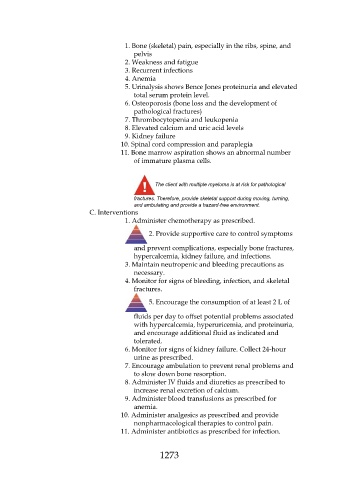Page 1273 - Saunders Comprehensive Review For NCLEX-RN
P. 1273
1. Bone (skeletal) pain, especially in the ribs, spine, and
pelvis
2. Weakness and fatigue
3. Recurrent infections
4. Anemia
5. Urinalysis shows Bence Jones proteinuria and elevated
total serum protein level.
6. Osteoporosis (bone loss and the development of
pathological fractures)
7. Thrombocytopenia and leukopenia
8. Elevated calcium and uric acid levels
9. Kidney failure
10. Spinal cord compression and paraplegia
11. Bone marrow aspiration shows an abnormal number
of immature plasma cells.
The client with multiple myeloma is at risk for pathological
fractures. Therefore, provide skeletal support during moving, turning,
and ambulating and provide a hazard-free environment.
C. Interventions
1. Administer chemotherapy as prescribed.
2. Provide supportive care to control symptoms
and prevent complications, especially bone fractures,
hypercalcemia, kidney failure, and infections.
3. Maintain neutropenic and bleeding precautions as
necessary.
4. Monitor for signs of bleeding, infection, and skeletal
fractures.
5. Encourage the consumption of at least 2 L of
fluids per day to offset potential problems associated
with hypercalcemia, hyperuricemia, and proteinuria,
and encourage additional fluid as indicated and
tolerated.
6. Monitor for signs of kidney failure. Collect 24-hour
urine as prescribed.
7. Encourage ambulation to prevent renal problems and
to slow down bone resorption.
8. Administer IV fluids and diuretics as prescribed to
increase renal excretion of calcium.
9. Administer blood transfusions as prescribed for
anemia.
10. Administer analgesics as prescribed and provide
nonpharmacological therapies to control pain.
11. Administer antibiotics as prescribed for infection.
1273

